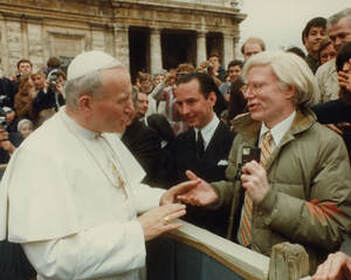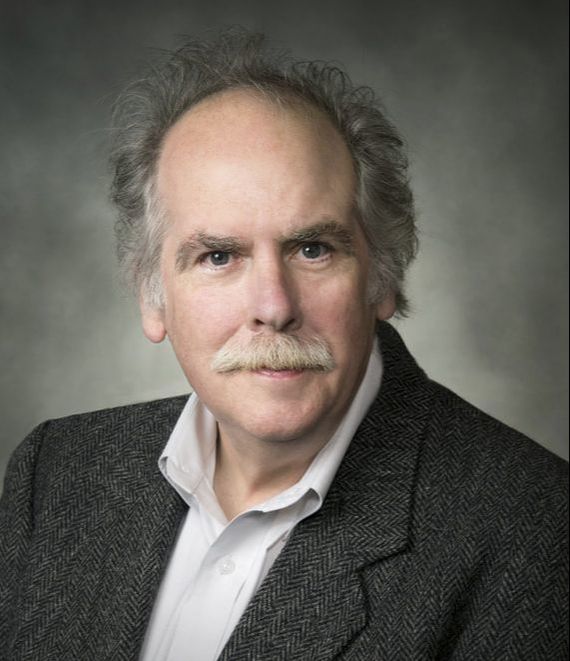 Andy Warhol meets Pope John Paul II in 1980 Andy Warhol meets Pope John Paul II in 1980 LONDON, ONTARIO – When I came into the Roman Catholic Church in 1984, my decision to convert was at least partially influenced by the testimony and example of people I admired who happened to be Catholic. Naturally enough, friends and associates held some sway, as well as public figures and artists of every stripe. But, incorrigibly bookish soul that I am, I was most particularly influenced by a mixed flock of congenial writers as temperamentally and politically diverse as John Henry Newman, Hilaire Belloc, G.K. Chesterton, Evelyn Waugh, Ronald Knox, Flannery O’Connor and Dorothy Day. There is, of course, no single Catholic type and this diversity of approaches has always been reflected in the rich multiformity of Catholic worship and devotion. But if it had occurred to me when I was steeling my will to jump the Tiber to compile a list of people who couldn’t possibly be Catholic, I might well have placed the American artist Andy Warhol (1928–87) – whose work I always found blandly uncompelling – near the top. And I would have been dead wrong as I and many other people were amazed to discover a few years later when Warhol died.
I’ve long wished there was a book that might explore how Warhol’s Catholicism ticked. And so I was sufficiently intrigued by the press reports of a recently published memoir, After Andy: Adventures in Warhol Land, by Natasha Fraser-Cavassoni, to give it a chance. The author certainly had promising domestic credentials. She is the daughter of English historian Antonia Fraser and the granddaughter of Catholic parliamentarian and outspoken social justice advocate Lord Longford. In After Andy, she looks back on her life as a society girl, fashion columnist, publicist and gossip-monger with Andy Warhol Enterprises. A lot of her earliest journalism appeared in Warhol’s witlessly prurient, celebrity-sniffing monthly magazine Interview which only stopped appearing in print last year and survives today as an electronic weekly, still cranking out its trademark puff pieces on such worthies of the higher inanity as Rupaul, Judge Judy and Marianne Williamson. Fraser-Cavassoni’s book is not a particularly edifying read for anyone of any religious or aesthetic sensitivity. But because of her own familial acquaintance with the faith and the timing of her employment with the world’s first and foremost pop artist (she began her tenure four days before Warhol’s sudden death in 1987 at the age of 58) she is able to cast some light on the fact that astonished much of the world on that February afternoon when Andy Warhol’s casket was carried down the steps from St. Patrick’s Cathedral in downtown Manhattan: this strangely desiccated artist who once proclaimed, “I want everybody to think alike. I think everybody should be a machine,” had been a lifelong, practising Roman Catholic. If I had to identify any single trait that I felt would preclude Catholic affiliation it would have been Warhol’s neurotic aversion to the idea of ‘incarnation’. With his over-riding sense of human detachment that impelled him to call his studio the Factory; with his rejection of traditional notions of craftsmanship in favour of stenciling and screen printing; with his rejection of uniqueness in favour of replication so that one can buy prints of his works but not originals; with his radical devaluation of the genuine and the singular so that even his so-called ‘portraits’ of famous actors and singers are arrayed in rows of near identical images just like his famous paintings of soup cans, bottles of Coke and Brillo pads . . . this was a man who never seemed to dig beneath the surface of anything, who insisted on being noticed and recognized in every situation but made certain that he was never really known. Never having much use for Warhol, I paid little attention to the accounts of his death and funeral and didn’t really begin to apprehend what his Catholic connection signified until 1989 when, in an idle moment of morbid curiosity, I leafed through a copy of the just-published Andy Warhol Diaries to see how – or if – he celebrated Christmas. Warhol didn’t exactly write these entries. Mainly as an aid to monitoring his finances, he would phone his assistant Pat Hackett every morning and leave an account on her Dictaphone of the previous day’s activities and expenses. She in turn transcribed and edited these daily notes for publication two years after his death. And so for Wednesday, December 25, 1985, he dictated: “Went to 90th and Fifth (cab $4) to meet Paige at the soup kitchen at The Church of the Heavenly Rest . . . Tama had already left because I guess it was too hard. And Paige was upset because she felt the food was so horrible for the people. But it’s just that we’re used to such unusually good stuff. It wasn’t worse than high school cafeteria food. And you see people with bad teeth and everything. And we’re so used to all these beautiful, perfect people. It’s such a different world . . . Passed out Interviews.” At Thanksgiving the next year he’s back manning the church’s soup line and barks at a colleague who’s come along and is being way too bossy with the folks lining up for food: “Victor, we’re here because we want to be.” And then again on the last Christmas day of his life he says: “I got up early and went to Paige’s and she and Stephen Sprouse and I went to the Church of the Heavenly Rest to pass out Interviews and feed the poor. There was food for people to take home too and I was giving everybody a lot. If there’s this many hungry people there’s really something wrong.” Certainly, there’s something absurdly comic about Andy Warhol handing out a charity dinner and a copy of Interview to the homeless and indigent. (Heck, why not give them a copy of Architectural Digest while you’re at it?) But it’s also awkwardly touching and, more than any art he ever produced, forced me to reconsider Warhol’s humanity and sincerity. In an interview with Rolling Stone in the fall of 2017 (and this was the piece that made me want to read After Andy), Fraser-Cavassoni speculated – in a much more thoughtful meditation than anything that turns up in her relentlessly frothy book – on what Warhol valued in the Catholic Church: “Being brought up Catholic gives a sense of hierarchical order, discipline and faith. Faith, when embraced, anchors the creative. I think it would also be fair to say that the romantically rich and multi-layered religion that forgives all – lest we forget! – allows unconventional traditionalists.” And so thirty-two years after his death when there can’t be many left alive with significant insights to share, I begin to suspect that the book I’ve long awaited is not forthcoming. Perhaps I’m asking for the impossible and there are no religious depths that can be plumbed regarding this wildly successful artist who was so resolutely fixated on surface appearances and celebrity. And the faith of Andy Warhol will have to hang there – inexplicable, inscrutable and mute – as just another one of those great Catholic mysteries.
1 Comment
Max Lucchesi
27/8/2019 10:10:54 am
Hello again. When one decides on a life changing decision one crosses the Rubicon not jumps the Tiber. Having said that your list of conservative Catholic converts did not surprise me. But should you have included the quasi Fascist Belloc in the same breath as Dorothy Day? I doubt the Catholic Workers Party and her social liberalism would have sat well with either him or Evelyn. I applaud the diversity of your reading when you have included Day and the atheist Mencken in your library of ultra religious conservatives..I'm hoping it's never too late for you, even though North American Catholicism has taken an ugly turn. The self congratulatory, self sanctifying homilies broadcast by Patrick Coffin and his brethren, which today is standard pap for the noisily professed devout is probably the reason why you found Warhol's unassuming Catholicism surprising.
Reply
Your comment will be posted after it is approved.
Leave a Reply. |
HERMANEUTICS
If you would like to contribute to the ongoing operations of Hermaneutics, there are now a few options available.
ALL LIFE IS A GIFT :
THE IMPORTANCE OF TRADITION :
Archives
June 2024
Categories
|

 RSS Feed
RSS Feed